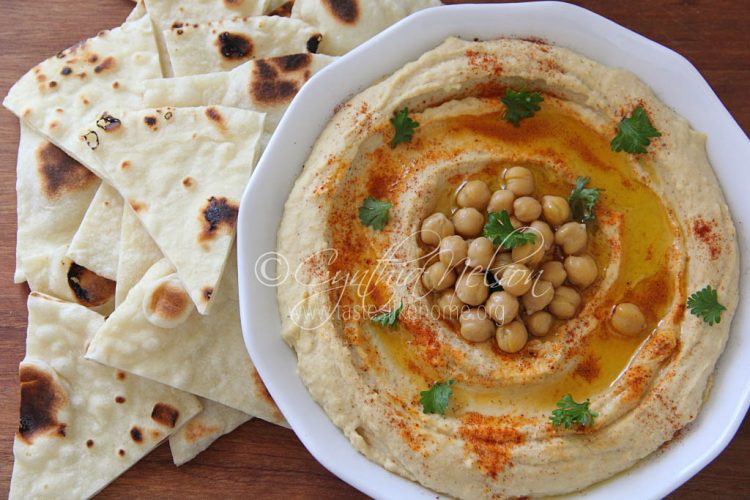 It is that time of the year – Lent – the period leading up to Easter. As usual, I have not made any dietary restrictions, instead, I have opted to include even more vegetarian dishes into my diet. These days, I find myself more into having flatbreads of all sorts with various spreads and dips made of roasted vegetables, cooked legumes, and canned fish like tuna. Chokas and Chutneys are right up there. One of the dips/spreads I’m planning to eat more of is Hummus.
It is that time of the year – Lent – the period leading up to Easter. As usual, I have not made any dietary restrictions, instead, I have opted to include even more vegetarian dishes into my diet. These days, I find myself more into having flatbreads of all sorts with various spreads and dips made of roasted vegetables, cooked legumes, and canned fish like tuna. Chokas and Chutneys are right up there. One of the dips/spreads I’m planning to eat more of is Hummus.
Hummus is the Arabic word for chickpea, and just like Baba Ghanoush (eggplant dip/spread), Hummus is a Levantine dish that is well known throughout the Middle East. When pureed with tahini (sesame paste), fresh lemon juice, salt, garlic and olive oil, chickpeas are transformed into a thick creamy concoction that can be used as a spread or a dip.

There are regional variations of the dish with regard to ingredients included in the puree and what tops it. For example, in Egypt, Hummus is flavoured with jeera (cumin) and other spices. I always put freshly ground jeera in my hummus; that smoky, aromatic flavour makes it really inviting. It’s just like how a Guyanese-style boil ‘n fry Channa would not be the same without jeera. In terms of toppings, chopped fresh coriander/cilantro, tomatoes, cucumbers, parsley, caramelised onions, sautéed mushrooms, whole chickpeas, olive oil, paprika, sumac, cured olives, pickles and pine nuts can all be used. Chopped, roasted, and marinated peppers make for a meaty addition. I also like to top hummus with chutneys and pastes such as pesto and tomato chutney.
The best tasting hummus, in my opinion, is made with chickpeas that have been rehydrated instead of canned chickpeas. They are creamier and do not have the briny tang that canned chickpeas do. I want to control and add my own acidity in the form of fresh lime/lemon juice. There is much debate about whether hummus should be made with the skins of the chickpeas removed or not. It is a matter of personal taste (and if you have the time to remove the skins). It’s long, hard work. I know from making Acarajé, the Brazilian Black-eye pea fritter. Hummus is creamier and a little lighter with the skins removed but honestly, the difference is marginal for the hours one would have to spend removing the skin from each chickpea.
Served as a dip with flatbread or your favourite salt crackers (biscuits), this is a meal; a satisfying one too. I make a thin, soft version of Sada roti to go with mine. Hummus is a welcome addition to a platter of crudités. You can also use it as a spread on sandwiches and wraps.
Here’s how I make Hummus
INGREDIENTS
● 2 cups dried chickpeas, rehydrated overnight,
cooked in lightly salted water
● ⅓ cup tahini
● Fresh lime/lemon juice to taste
● 1 heaped teaspoon freshly ground cumin or to taste
● Salt to taste
● ½ – ¾ cup cooking liquid (from chickpeas)
● Olive oil, paprika and chopped parsley to garnish
DIRECTIONS
1. Drain the cooked chickpeas well, reserving the amount of cooking liquid indicated in the list above.
2. Tip the peas in the bowl of a food processor along with the tahini, cumin, lime/lemon juice and salt to taste. Puree until smooth.
3. With the processor running, add ½ cup to ¾ cup water to the mixture to loosen it, making it easy to spread/dip. Taste for salt and acidity and adjust to suit your taste. Pulse a few times to mix well.
4. Transfer mixture to a bowl or deep serving dish; using the back of a tablespoon, swirl the top to make an indentation. Drizzle with top quality olive oil, dust with paprika and sprinkle or dot with parsley.
5. If not serving immediately, cover with plastic wrap placing the wrap directly on top of the hummus to avoid it drying out or developing a skin. Garnish just before serving.
NOTES
● 1 cup dried peas/beans rehydrated yields 2 cups.
● The hummus can be made a day or two ahead of serving and stored in the refrigerator in an airtight container. First cover with plastic wrap directly touching the hummus to prevent it drying out and forming a skin. When you are ready to serve, remove the container from the fridge and let it come up to room temperature or warmer before removing it from its storage container and transferring it to a serving bowl/dish. Garnish and serve.
What are some things that you are adding or taking away from your diet for Lent?
Cynthia




